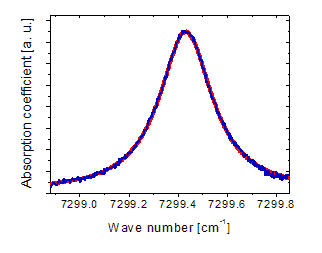Direct Tunable Diode Laser Absorption Spectroscopy (dTDLAS)
|
Direct tunable diode laser absorption spectroscopy is a measurement technique with which the concentration gases can be determined. It utilizes the ability of diode lasers to be operated at different wavelengths in a certain wavelength window. The process of continuously changing the output wavelength of a diode laser is called tuning. By means of this tuning process, it is possible to scan over an absorption line of a gas, e. g. water vapor. After choosing an appropriate absorption line, the absorption along this line is measured wavelength-resolved, as depicted in the figure. For determination of the concentration of the investigated gas, a fit to the shape of the absorption line (Voigt profile) is performed. The area below the fit curve is directly proportional to the concentration of the gas along the absorption path. What discriminates dTDLAS from other measurement techniques is that there is no need to calibrate a dTDLAS instrument if the strength of the used absorption line is known. This is the case, since absorption line shape and strength are an intrinsic property of the gas molecules of the examined species. In addition, dTDLAS offers other advantageous properties, such as high sensitivity (absorptions of 10-4) and time resolution (1 Hz and better). |
dTDLAS-signal (blue) of an absorption line of water vapor. In order to determine the concentration of the water vapor, a Voigt fit (red) to the line shape is performed. |
Three different TDL-hygrometers are in operation at AIDA to simultaneously determine the water vapor and total water concentration inside the simulation chamber.
For further information, please contact Dr. Harald Saathoff.
More details on TDLAS can be found e.g. in:
P. Werle et al., Near- and mid-infrared laser-optical sensors for gas analysis, Opt. Las. Eng. 37 (2-3), 101-114 (2002)

